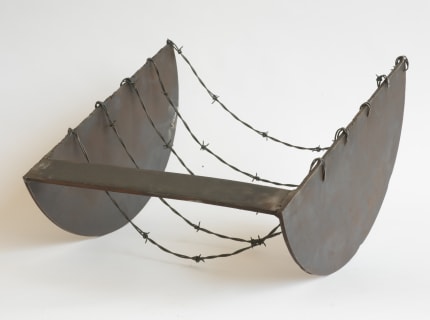A major figure in African-American art, Melvin Edwards (b. 1937) started as a sculptor in the early 1960s in Los Angeles before moving to New York in 1967. Known for the welded steel “Lynch Fragments,” an ongoing series that he started in 1963, Edwards’s work addresses his personal or historical experiences. Homages to significant personalities of African-American history are often to be found in the titles of his abstract constructions elegantly displayed in space. He is currently presented in two exhibitions at the Baltimore Museum of Art (Generations: A History of Black Abstract Art and Melvin Edwards: Crossroads) in addition to his solo-show, Painted Sculpture, at Alexander Gray Associates, where this discussion took place.
Mel Edwards: So … your accent says you’re from where?
Choghakate Kazarian (Rail): I was born in Armenia but my family went to France when I was eight, so I grew up in Paris.
Edwards: Lot of Armenians in the US…
Rail: Yea! specially in LA.
Edwards: I played football years ago and a very famous placekicker, Ben Agajanian, was Armenian. I lived in LA for eleven years. But in the art world Gorky is—you know.
Rail: Gorky is our Armenian hero! [Laughter]
Edwards: Exactly! And he was a close friend with one of my teachers, so we had a lot of information on him these years. Hans Burkhardt who was born in Switzerland. He, Gorky, and Willem de Kooning were three friends here in New York, immigrants studying art. Hans talked a lot about Gorky, in fact he brought paintings by Gorky to our classes. They weren’t typical Gorky paintings, they were Gorky’s studies of Cézanne or Picasso because in those days they studied a lot by copying the works of other artists. He expressed that he and de Kooning were more like students of Gorky’s. They were friends but in terms of who knew things, Gorky was more advanced than them.
Rail: Currently your work is at the Baltimore Museum of Art where you have a solo exhibition, Melvin Edwards: Crossroads, and are included in the group show Generations: A History of Black Abstract Art. Can you tell us about this curious vicinity with Leonardo Drew (presented in the same room), who is from a younger generation?
Edwards: I know him well, he was a student of my friend Jack Whitten and they were close. In terms of the exhibition, that is the creation of whoever organized it. I had nothing to do with being paired with Leonardo. If I were putting us in the same situation I would have a work of mine that was as large as his, so the difference in scale is … well, I wouldn’t have done it that way, but they don’t have a big work of mine and they are only showing what’s in their collection. Now, on an art dynamic level, my little “Lynch Fragments” carry with anybody’s big painting if you go and stand in front of them because they’re hung at eye level—that is 69 inches from the floor. And I use a logic of distance; a natural one; it’s like the principles of the size of doors: they fit all human beings. In architecture, people definitely pay attention to that. As a sculptor, I pay attention to that kind of thing. There should be, if I were talking about those kinds of works of mine, at least three. So you get that principle of a natural arm’s length, 36 inches from here to here and from here to here [extending his arms], so you can put three pieces at distance.
Rail: In the exhibition Now Dig This!: Art and Black Los Angeles 1960–80 that took place at the Hammer museum in 2011, you were presented as a frontrunner...
Edwards: That’s because the exhibition began in 1960, and because Kellie Jones’s primary focus was on the people who were part of the Brockman Gallery. And since I left Los Angeles in January 10th, 1967 (Brockman Gallery opened in July of 1967) I had nothing to do with them. There is a pre-history to that, which somewhat came out in Soul of a Nation but also in Pacific Standard Time (2010), an exhibition that the Getty sponsored of the history of art in southern California. Artists that are in Soul of a Nation from California like Daniel Johnson and Virginia Jaramillo, we were friends, David Hammons, or people like that. David for instance: I was teaching at the Chouinard Art school in 1965–’66 before I moved to New York; he went into art school at Los Angeles County Art Institute and was taught by Charles White, who is a generation before me. I’m five years older than David but we knew they were affected by our work, but there was no specific group movement among us, we had relationships. I was close with people like Marvin Harden and Ron Miyashiro, a Japanese artist.
Miyashiro and Ed Bereal, an Afro American artist, were part of an exhibition called War Babies with Larry Bell and Joe Goode and there is a famous poster because they’re four different ethnic groups in that photograph. It’s before the stuff that shows up in Soul of a Nation. Miyashiro, from Hawaii, lived right next door to me in Los Angeles. We babysat for each other’s families, that kind of thing, he and I were very close, discussing art and life.
...
Read full interview at brooklynrail.org.

